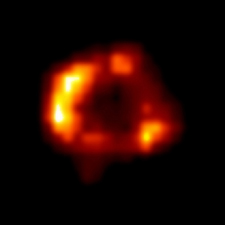Supernova 1987A, the first supernova observed in 1987, was the brightest and nearest supernova to Earth in almost four centuries. Before it exploded, it was a luminous blue giant star that put out 100,000 times as much power as the Sun. After the explosion, the expanding debris glowed in visible light with the power of 100,000,000 suns for four months.
Supernova 1987A is located in a nearby galaxy called the Large Magellanic Cloud. This galaxy is about 160,000 light years from Earth, so when it was first observed by optical telescopes in 1987, the event had actually occurred about 158,013 B.C. We are seeing a delayed-action replay of the actual event. When astronomers say that SN1987A is only 13 years old, they mean that it is has been 13 years since the outburst was observed on Earth.
A supernova explosion is among the most violent events in nature. When the nuclear power source at the center or core of a star is exhausted, the core collapses. In less than a second, a neutron star is formed. As infalling matter crashes down on the neutron star, temperatures rise to many billions of degrees Celsius. Within hours, all but the central neutron star is blown away at speeds in excess of 50 million kilometers per hour. This exploding matter creates a gigantic shock wave that speeds ahead of a shell of gas that has temperatures of millions of degrees.
Over the next few thousand years, the expanding shell of hot gas will glow in X rays. Eventually after rumbling across several thousand light years, the shell will disperse. In this way, the supernova spreads the heavy elements created in the star and possibly triggers the formation of new stars from a cold interstellar cloud.
With Supernova 1987A, scientists have an opportunity to watch the early phases of this action from a close but not too close vantage point. They were able to detect energy from the first seconds of the explosion in the form of fundamental particles called neutrinos. For the first 500 days, the visible light was observed to fade gradually, powered by the radioactive decay of cobalt into iron. Gamma rays from the radioactive decay were also observed.
With the Chandra X-ray Observatory and the Hubble Space Telescope astronomers can observe the evolution of the hot gas shell, watch as the shock wave heats surrounding gas, measure the amounts of the various elements ejected in the explosion, and search for the neutron star that should have been formed in the explosion. So far, the neutron star has not been detected.
Present Chandra observations show the hot gas shell sweeping toward a ring of matter ejected by the star thousands of years before it exploded. This ring has been observed by Hubble to brighten during in the past two years, presumably due to the collision of the shock wave with outer parts of the ring. The full impact of the collision of the shell with the ring will occur in the next few years. Then Supernova 1987A will become a hundred times brighter in X rays, opening up a new act in the majestic drama of cosmic death and renewal that is unfolding under the watchful eyes of the world's most powerful telescopes.
[ Press Index ] [ Fact Sheets ]


